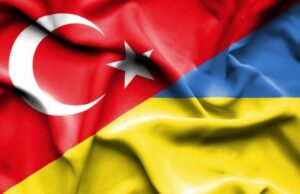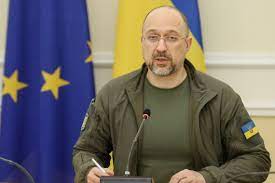
An agreement between the Government of Ukraine and the Government of Turkey on the establishment of a system for the electronic exchange of preliminary information on goods and vehicles moving between the parties was signed in Istanbul on Friday as part of a meeting between President of Ukraine Volodymyr Zelenskyy and President of Turkey Recep Tayyip Erdogan.
“According to the document, information exchange will be carried out between the State Customs Service of Ukraine and the Ministry of Trade of Turkey. Based on the agreement, a system of electronic exchange of preliminary information will be created, through which a predetermined set of data will be exchanged in electronic form,” the press service of the President of Ukraine reports.
It is noted that the information received by the customs authorities of the parties will help speed up the movement of goods and vehicles across the borders of both states, as well as counteract customs offenses.
On behalf of Ukraine, the agreement was signed by Defense Minister Rustem Umerov, and on behalf of Turkey – by Trade Minister Omer Bolat.

Volodymyr Zelensky has arrived in Istanbul to meet with Turkish head of state Recep Tayyip Erdogan.
The airplane with the Ukrainian leader and his accompanying delegation on board landed at Ataturk Airport, Turkish media reported.
As part of the visit of the Ukrainian delegation, Zelensky will meet with President Erdogan. A joint statement of the two leaders is expected to be signed following the talks.

Ukraine is ready to extend the transit of Russian gas through its gas transportation system (GTS) at the initiative of the European Union countries, but will not extend the current contract or sign a new one with Gazprom, Prime Minister Denis Shmygal said at a press conference in Kiev on Monday.
“We are certainly not going to negotiate with the aggressor country to extend (the transit contract) and put our signatures under the agreement, but we have had repeated talks with European leaders on the basis of the European Commission. If European countries will act as a consortium or one of the European partners will act as a transit company for its own gas, we are ready to provide such a service. Here the initiative is on the side of the EU and our European partners,” he said.
“Group, association, consortium… It could be the EC, a group of European countries that are interested in preserving transit,” Shmygal specified.
At the same time, according to the Prime Minister, the GTS of Ukraine is ready to function without the transit of Russian natural gas.
As reported, the transit of Russian natural gas through the gas transportation system (GTS) of Ukraine in 2023 decreased by 28.4% (by 5 billion 812.6 million cubic meters) compared to 2022 – to 14 billion 646.6 million cubic meters.
The contract between Naftohaz Ukrainy and Gazprom for the organization of transportation, the transportation agreement between NAK and OGTSU, as well as the inter-operator agreement between OGTSU and Gazprom were signed on December 30, 2019. The contract provides for transit of 40 billion cubic meters of gas per year in 2021-2024.

Ukraine intends to create an Investment Attraction Agency as a single entry point for investors in the Ukrainian private sector, First Deputy Prime Minister Yuliya Sviridenko said on Facebook.
“To ensure that all investors wishing to invest in the private sector in Ukraine have a single point of entry, we are working on the launch of a single institution – the Investment Attraction Agency,” she wrote following a visit to London, where she discussed its creation, including with the London Stock Exchange (LSE).
According to her, during the meeting, LSE specialists assured that they are ready to provide their expertise and help build this institution.
Sviridenko said she also met with British International Investment, which last summer at a conference on Ukraine’s reconstruction in London said it was ready to allocate GBP250 million to finance the private sector in Ukraine, mainly for post-war reconstruction.
“These funds will be available from April through the Co-investment platform. What can we do together with the private sector already now to get this funding? Prepare quality projects. For this purpose we also attract partners to jointly do feasibility study, “- First Deputy Prime Minister said.
She added that attracting investment and financing to Ukraine was also the main topic of negotiations with the European Bank for Reconstruction and Development, the London Stock Exchange and TheCityUK, UK Export Finance (UKEF).
“We are working with UKEF to attract investments in the defense sector. We have also opened a GBP3.5bn limit for Ukraine. Several companies have already received insurance, one of them yesterday during our visit to London. We plan to expand cooperation, in particular, we discussed the possibility of insuring suppliers of equipment in the field of military demining,” Sviridenko wrote, in particular.

Ukraine’s Ministry of Communities, Territories and Infrastructure Development has agreed with Turkey’s Ministry of Transport and Infrastructure to extend the liberalization of freight transport, the ministry’s press service said on Thursday. According to the ministry, the “transport visa-free zone” or liberalization of freight transport with Turkey, includes bilateral freight traffic and transit traffic, the ministry said.
“Of all the exports we deliver to Turkey, about 15% are by road transport. Turkish companies import to us exactly by road transport almost 60% of the total volume of goods,” said Deputy Prime Minister for Reconstruction – Minister of Community Development, Territories and Infrastructure Alexander Kubrakov.
As a result of the agreement, the parties no longer need permits for cargo and transit transportation. At the same time, permit-free passage is also valid for the entry of empty trucks.
In addition, the Ministry of Transport agreed with the Turkish side to increase the number of permits for cargo transportation to/from third countries and bus transportation to 3,500 permits and 400 permits, respectively.
“We are working on the possibilities of performing irregular bus transportation – we have agreed on 400 permits for such trips. In the near future, part of these permits will be delivered to Ukraine for issuance to carriers,” – emphasized Deputy Minister of development of communities, territories and infrastructure Sergiy Derkach.
As reported, liberalization of freight transport is available with 35 countries, including the European Union. Last year, the team of the Ministry of Recovery managed to agree on the possibility with Norway, North Macedonia and extend the relevant agreement with Moldova.

Prime Minister of Ukraine Denys Shmyhal says that Ukraine and Japan have signed 56 intergovernmental agreements, memorandums, and arrangements between businesses and local authorities at the Economic Development and Recovery Conference.
“56 documents were signed by representatives of Ukraine and Japan at the Economic Development and Recovery Conference in Tokyo! Among them are intergovernmental agreements, memoranda, and agreements between businesses and local authorities,” Shmyhal wrote on his Telegram channel.
In particular, an intergovernmental convention on the avoidance of double taxation was signed; more than a dozen agreements to support Ukraine’s recovery with powerful Japanese organizations (JICA, JETRO, the NEXI Export Credit Agency and the Japan Bank for International Cooperation); grant agreements for the implementation of recovery programs, as well as a number of documents between the Ministry of Agrarian Policy of Ukraine and Japanese companies providing Ukraine with various agricultural machinery and equipment; an intergovernmental memorandum on supporting Ukraine’s recovery with the
“Naftogaz agreed on a wind energy project; the Ukrainian gas transportation system operator signed a memorandum on preparations for the modernization of gas compressor stations. According to the Prime Minister, documents were also signed in the fields of energy, telecommunications, infrastructure construction, and ecology.
“Japan has already shown leadership in financial support for Ukraine. Now Japan should become one of the leaders of Ukraine’s recovery and investment in our economy,” Shmyhal summarized.